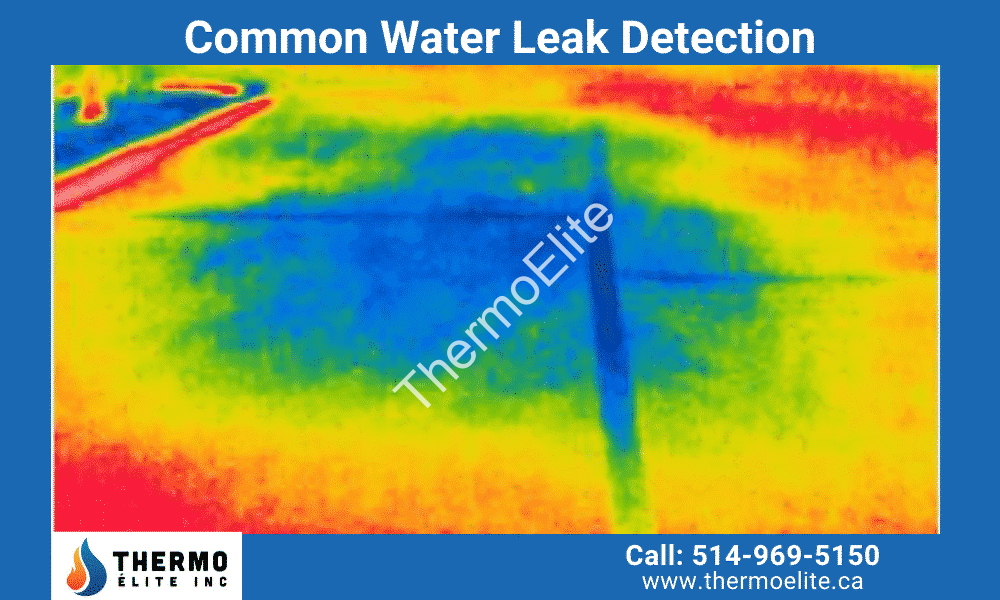Are you tired of dealing with water leaks and not knowing where to turn for help?
Discover the answers to some of the most common water leak detection questions and learn how to identify, locate, and resolve leaks before they cause significant damage to your property.
Water leakage is a very common issue for homeowners. There could just be a small niggling leakage or a major problem like a slab leak; leakage is a common and frequently occurring plumbing challenge. Timely detection with the use of thermal imagery helps deal with it effectively.
The advent of thermal imagery has made the entire process very effective and efficient. Thermal imaging can detect leakages by detecting a change in the temperature of a surface. If water falls from a leaking pipe on a surface, the change in its temperature will tell where the leak is.
It’s always useful to learn a bit about leakages as knowledge can help you solve pending issues. Here are the reasons behind pipe leakages.
Pipe Leakages, the Most Common Reasons
- Excessive Pressure – All pipes are designed in such a manner that they can withstand pressure. However, when the pressure is too much, the pipe might suffer damage. If the pressure of water passing through the pipe gets too high, there’s every possibility of it cracking resulting in a leak.
- Cracks – When a pipe cracks, it’s only natural that the water passing through it starts seeping out. The technology of making pipes is very advanced these days. Despite that, there’s every possibility of a pipe cracking with the water passing through it leaking out. Thermal imagery helps detect cracks on time helping in timely repairs.
- Corrosion – The quality of the water matters here. It’s decided by certain factors. They are-
- The presence of chemicals in the water
- The presence of pH in the water
- The temperature of the water
- The pressure and speed of the water passing through the pipes
- Oxygen content in the water
- We suggest that you have regular water treatment done. That’s because the factors we have mentioned above can cause corrosion that can damage pipes.
How do you get to Know about a Leak in Your Home?
Unless of course something drastic happens to the water being supplied to your home, it’s difficult to know when exactly there has been a leak. Despite that, there’s quite a good chance of spotting leaks if you are aware of certain telltale signs. We discuss them below.
- Drop in the Water Pressure– The water supplied to you flows through the pipes at a certain velocity. This is what causes pressure on the walls of the pipes. If you find a fall in the force with which the water flows out of the taps or other fittings, it’s because a leak has caused the water pressure to drop.
- The floors, ceilings, and walls stained by water– Are the floors in your home getting discolored, or is the paint on your walls peeling off? If yes, it’s an indication that water has pooled there. Sadly, the damage is already done even though you might not see any moisture. Floors and walls that are warped are a clear sign of water having leaked and it needs to be repaired immediately. It’s difficult to spot the exact location of the leakage. Thermography helps do so very effectively.
- A higher than usual water bill– Water usage at your home must always consistent. That’s why the amount you pay as your water bill remains at a steady figure. The moment you see a sudden rise in your water bill, you should know that there’s a leaking pipe somewhere around. If the water usage in your home has risen due to reasons you are aware of, any sudden rise in your water bill figure indicates that there is a leaking pipe.
- Formation of Mildew– Mildew growth at places with a constant flow of water is natural. But when they start popping up at places where they aren’t supposed to, and they do so rapidly, it’s a sign that there surely is a leakage.
- Unusual Noises– Do you hear a hissing noise or the noise of dripping? If you do hear such a noise every time you pass by a sink or a bathroom at home, there’s a chance that there’s a pipe leaking somewhere in your home.
- Formation of Sudden Puddles– Do you see a wet patch on your carpet or are there spots on your floor that have been discolored? If yes, it’s a sign that there is a leaking pipe beneath the floor.
- Pipes that are Rusty– Iron loses its strength when it gets rusty. With water flowing through the pipes fast, there’s always pressure on the pipe walls. That’s why a rusty pipe that’s weak is surely to crack sooner rather than later.
- Wet Spots across your Yard– Just as in the case of a wet floor, wet spots in your yard indicate a leakage beneath the ground in some outdoor pipe. However, do check the garden hose before you decide that there’s a leak in an underground pipe. Also, do check for any leak at the spot where the hose connects with the spigot. In case there is one, it’s time to get a new water hose.
More Signs and Tips that help in Spotting Leakages
- Checking the Water Meter– Doing this is easy. Check water meter reading before you go to bed. Make sure that no water is used during the night when everyone will be sleeping. The next morning, check the reading again. If the meter reading has changed, it indicates that there’s a leaking pipe in the home.
- Checking the Toilet– Even the smallest of leaks can result in quite a significant amount of water loss. An easy to perform experiment to check whether there’s any leakage or not is to add some food coloring, just enough to see it in the water in your tank. Give it thirty minutes. Check the toilet bowl after you are back in the toilet. If the water in the bowl is colored, there must be a leak somewhere and that explains why the color has seeped into the water. However, thermal imaging would be the foolproof technology for detecting such leaks.
- Don’t forget to check the Washing Machine– The moment you see your washing machine hose bulge, fray, crack or leak at the ends, do change it immediately. To avoid flooding in your home, give your washing machine enough care, it needs the care. There should be a gap of at least 4 inches between the washing machine and the water source. This prevents your washing machine hose from having kinks.
How to look for Leaks inside your Home
If you feel that you have a leak somewhere in your home, the bathroom, the kitchen, or any of the walls but can’t quite locate it, here’s what you should do.
- The Bathrooms:Go through a step by step check. Start with the sink. Do you see any moisture? If you don’t, next is the shower. It’s simple really. Just splash a bit of water on the shower door and see if there’s any spillage on the floor. If you see a water spill on the bathroom floor, there’s a leak. After that, don’t forget to see the state of the caulking with your fixtures. If you find any cracks in the caulking, that’s likely to be the source of the leak. Thermal imaging helps a great deal in locating such cracks.
- The Kitchens: The most common source of leakage inside kitchens is the sinks. If you find the cabinet bottoms stained with water or if you find that the P trap is slightly wet at the bottom, there’s a strong likelihood of the sink being the source of a water leak. A tile in your floor loosening is also a sign of a leak in the sink.
- Check the Walls too: It’s easy. You can’t miss the dark stains on your wall. Yes, that’s where the leak is. However, locating the exact spot of the leak is still a challenge. Observe where the stain has started and where the end is. That’ll at least tell you where the base of the leak is. A qualified thermographer would be very effective in these situations.
How do you prevent a Leak at your Home?
- Don’t stuff cabinets below the sink: Make sure that you don’t stuff the cabinets below the sink with goods like household items. If you were to do so, there would always be a chance of the things stuffed into the cabinet hitting the walls of the pipes. That might weaken the pipe causing it to leak.
- Replace when it’s better to do so than repairing: There are quite likely to be situations when a certain pipe fitting in your house has corroded or rusted beyond repair. In such situations, having a repair done can at best be a stop-gap arrangement. It’s best to get the fitting replaced altogether.
- Know the location of your main shutoff valve: The best way to deal with a leak in an emergency is to know where the shutoff valve is located in your home. The moment you notice a leak, turn out the shutoff valve. This is a more viable solution than turning off the water from the water meter.
The Dangers that Come with a Hidden Leak
When you delay repairing a leak, things get serious. It weakens the walls of your home causing severe damage to it. Such damage is not just hard to fix, it’s a very costly affair too. Again, leaks can be a hazard to you and your family’s health. Dirt might get into your water through a crack in a pipe. It’s therefore a must that a water leak is never overlooked. Do deal with it the moment you spot one. That’s why we suggest that regular checks using the latest techniques like thermal imagery be carried out.
Early detection and repair of leakages in pipes comes with certain benefits which include,
- Loss of water is reduced or eliminated
- Elimination of any chances of damage to property that can be caused by pipe leakage
- Emergency repairs might not ever be needed
- The need for water treatment along with pressurization is reduced
Could Leaks cause Bigger Damage when Ignored?
Yes, it absolutely can. No matter how small a leak may be initially, if not dealt with on time, it can grow into a major problem. As the saying goes, “A stitch in time saves nine,” a timely check of the source of leakage prevents it from getting large causing major damage. Water leakage from a pipe can cause severe erosion that makes even a small leak grow large eventually. That’s why a lack of timely intervention may make you end up with a repair job that burns a hole in your pocket.
Do we have all Water Leaks rising to the Surface?
No, all leakages in your home don’t rise to the surface. That makes things difficult. A hidden leak in a sewer pipe, or a deserted pipe or a rainstorm pipe doesn’t quite rise to the surface. If such leaks aren’t detected, it’s only stating the obvious that your home will be severely damaged. It’s, therefore, best to take the help of a thermography professional who would use a thermal imaging device to detect the leak. Have it repaired to avoid major damage to your home.
Conclusion
Early detection and prompt repair is the only way to prevent greater damages to your property. Delay in detection and repair can result in further damages. Regular checks for possible leakages using efficient tools like thermal imaging can help in early detection and timely repair.



Add Comment